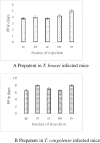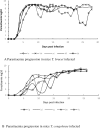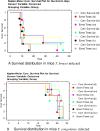Route of inoculation influences Trypanosoma congolense and Trypanosoma brucei brucei virulence in Swiss white mice
- PMID: 31220132
- PMCID: PMC6586304
- DOI: 10.1371/journal.pone.0218441
Route of inoculation influences Trypanosoma congolense and Trypanosoma brucei brucei virulence in Swiss white mice
Abstract
Experiments on infections caused by trypanosomes are widely performed in Swiss white mice through various inoculation routes. To better understand the effect of route of trypanosome inoculation on disease outcomes in this model, we characterised the virulence of two isolates, Trypanosoma brucei KETRI 2710 and T. congolense KETRI 2765 in Swiss white mice. For each of the isolates, five routes of parasite inoculation, namely intraperitoneal (IP), subcutaneous (SC), intramuscular (IM) intradermal (ID) and intravenous (IV) were compared using groups (n = 6) of mice, with each mouse receiving 1x104 trypanosomes. We subsequently assessed impact of the routes on disease indices that included pre-patent period (PP), parasitaemia levels, Packed Cell Volume (PCV), bodyweight changes and survival time. Pre-patent period for IP inoculated mice was a mean ± SE of 3.8 ± 0.2 and 6.5 ± 0.0 for the T brucei and T. congolense isolates respectively; the PP for mice groups inoculated using other routes were not significantly different(p> 0.05) irrespective of route of inoculation and species of trypanosomes. With ID and IP routes, parasitaemia was significantly higher in T. brucei and significantly lower in T. congolense infected mice and the progression to peak parasitaemia routes showed no significant different between the routes of either species of trypanosome. The IM and ID routes in T. congolense inoculations, and IP and IV in T. b. brucei induced the fastest and slowest parasitaemia progressions respectively. There were significant differences in rates of reduction of PCV with time post infection in mice infected by the two species and which was more pronounced in sc and ip injected mice. No significant differences in mice body weight changes and survivorship was observed between the routes of inoculation. Inoculation route therefore appears to be a critical determinant of pathogenicity of Trypanosoma congolense and Trypanosoma brucei brucei in murine mouse model of African trypanosomiasis.
Conflict of interest statement
The authors have declared that no competing interests exist.
Figures



References
-
- TN'Djetchi M, Ilboudo H, Koffi M, Kaboré J, Kaboré JW, Kaba D, et al. (2017) The study of trypanosome species circulating in domestic animals in two human African trypanosomiasis foci of Côte d'Ivoire identifies pigs and cattle as potential reservoirs of Trypanosoma brucei gambiense. PLoS Negl Trop Dis 11: e0005993 10.1371/journal.pntd.0005993 - DOI - PMC - PubMed
-
- Bengaly Z, Sidibe I, Boly H, Sawadogo L, Desquesnes M (2002) Comparative pathogenicity of three genetically distinct Trypanosoma congolense -types in inbred BALB/c mice. Veterinary Parasitology 105: 111–118. - PubMed
Publication types
MeSH terms
LinkOut - more resources
Full Text Sources
Miscellaneous

